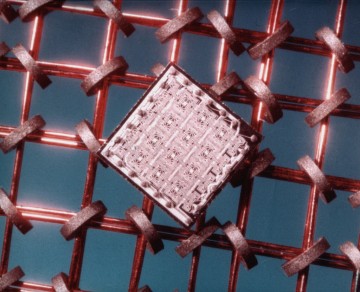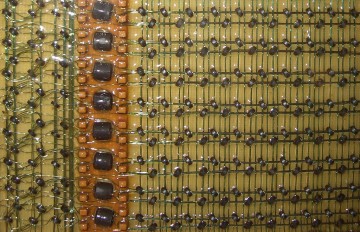64-bit Chip
This vintage photo portrays the previous paradigm shift in electronic memory? This is a 64 bit (not KB, MB or GB) memory chip from the mid 60s on top of the industry standard at the time ? core memory (hand woven iron rings that store a 1 or a 0 magnetically). One of the original IBM engineers, who first put memory chips into a computer, sent me this print. The chip is a SP95 Phase 2 Buffer Memory (The Phase 1 chip was 16 bits), produced at IBM Essex Junction, VT. SP95 was the first commercial application of IC memories in a computer (the IBM S-360, model 95 scientific computer that shipped to NASA in 1966). The IC grabbed the proverbial brass ring, and had its day in the sun.
Primitive Memories
Core Memory:
One of the core memory boards hanging in our office collection? the industry standard for computer memory in the 1960?s. Here you see 18 bytes of memory in 2x3 inches, where each hand-woven ferrite ring can be individually magnetized or not, representing 1 or 0.
Until I took this macro zoom shot, I had not noticed the unusual wiring for the cores on the left. The wiring on the right is standard to core memory arrays (to read and write a magnetic bit to the iron core at the intersection of a particular row and address line).
The core memory arrays would often have parity bits for each data row (for error detection). Perhaps the wiring on the left implements a parity operation. It has repeating loops across pairs of rows. Does this look familiar to anyone?
(The only marking on the 7x9? board is Xak 4292. It has 300 bits in the memory array, with 15 pairs of rows with 10 ferrite cores in each row.)
Bild: jurvetson


